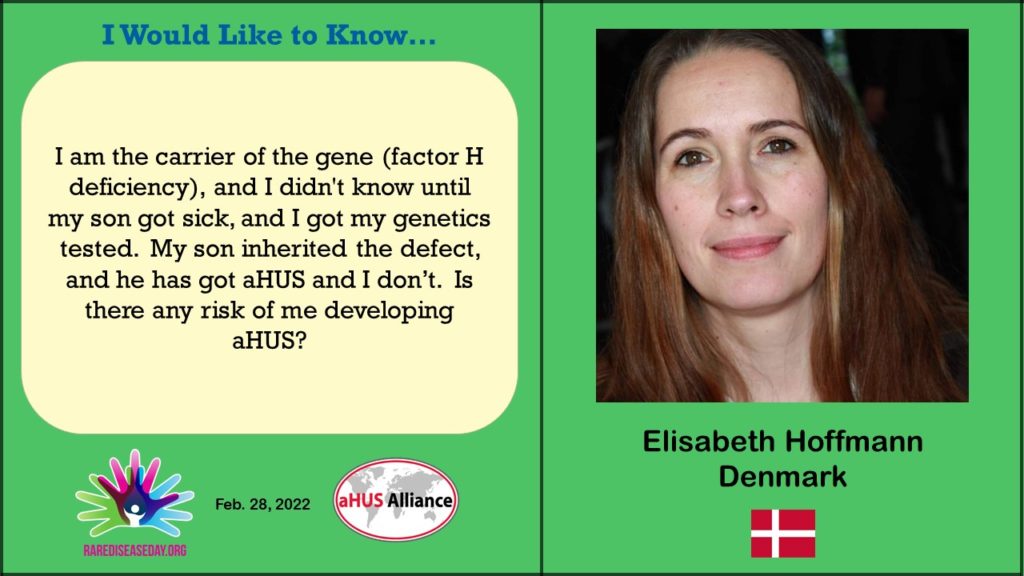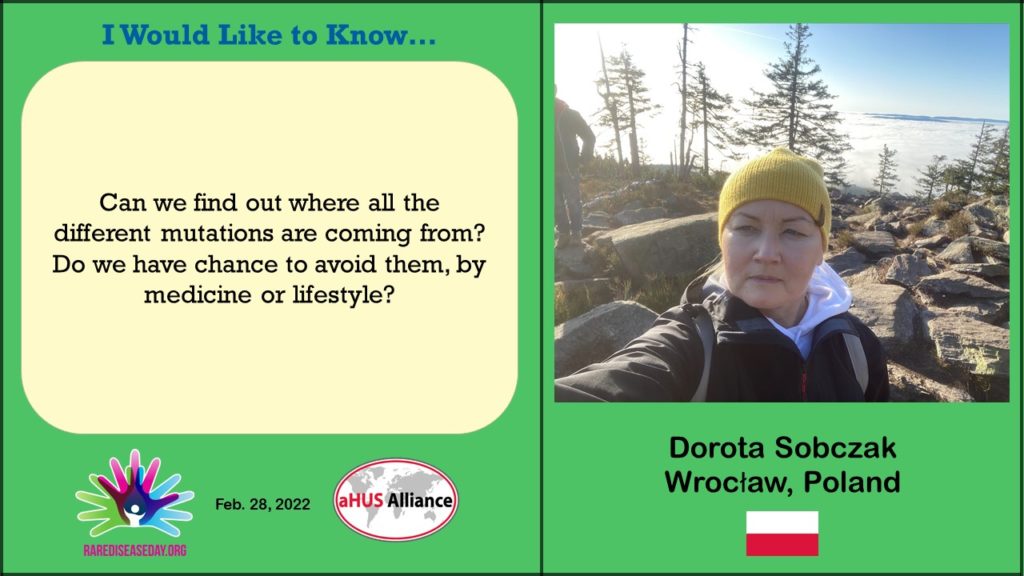Although aHUS has genetic causes, in the majority of cases it is found that the patient is the only one in the family with the genetic susceptibility for aHUS. That is called sporadic aHUS. If the mutation is passed on by that patient and/or more than one family member has the same genetic variant it is known as familial. Inheritance of a genetic cause does not an mean an onset is certain in all , and some members may onset while others do not. That is called the incomplete disease penetrance.
You now know, Elizabeth, that you are susceptible to aHUS. You didn’t until it manifested in your son and you were genetically tested. Pregnancy did not trigger the disease in you and that was a risky time for women susceptible to aHUS as it is a strong trigger. You probably have had many of the infectious illness triggering hits too. Maybe even those experienced by your son.

Your predisposing variant is in Complement Factor H ( CFH) of your Complement System. In Europe, CFH tends to be most commonly implicated in aHUS , something that is shared with aHUS patients in the USA , probably because of historic immigration. In other regions of the world it is not as prevalent.
So why your son and maybe not you?
Although it is almost certainly not the same mutation as yours , a study of some families in England with a CFH mutation might help give you an answer to your question Elizabeth.
These families shared a genetic variant in their CFH. The study found it when testing several generations of the families. It was also presumed for those family members who had died from kidney failure. They were likely to have a common lineage from an ancestor many generations before and several hundred years ago.
When the living family members ( 9 had died) were tested, 15 were found to have the genetic variant and had onset with aHUS. Eighteen other family members had the genetic variant but had not onset. Some of them had had multiple pregnancies and yet did not onset.
In those who had onset there were peaks of onset incidence at 4 years , usually boys, 27 years , 60 years and 70 years. By 70 just over two thirds of the genetically predisposed had onset.
But something had been spotted. At conception we each can inherit some of the DNA of our mothers and fathers. In the 42 family members in the study all had inherited the disease causing part of the DNA from a aHUS carrier parent and some from the other non carrying parent.
The study found a haplotype /polymorphism ( a more common variant in the general population) in the allelial , a part of DNA , that was from the non carrying parent. It appeared to affect aHUS penetrance significantly.
In the family tree of one of the three families, it is possible to see the experience of three direct line members, a grandmother , a mother and a grandson.
The grandmother is an aHUS carrier but is unaffected. She had a daughter who also carries the mutation but is unaffected. The daughter had a child who onsets with aHUS. The son has a different haplotype to the mother and grandmother. The non carrying father has “provided” this different polymorphism, which put the child at higher risk susceptibilty for aHUS. What had “protected” his mother and grandmother had been switched in the child. When the trigger came he onset at around four years of age
Had he:
- Not inherited the aHUS predisposing variant/mutation from the mother, he could not have had aHUS;
- Inherited the predisposing variant/mutation, but also the protective/ less risk halptoype from his mother – he would very unlikely have had aHUS, but might;
but he :
- Inherited the predisposing variant/mutation from his mother and also the unprotective/greater risk haplotype from his father – that put him at much more risk of having aHUS and most likley do so when a strong enough trigger hit and it did so and he got aHUS. ( He survived)
This can happen in other families.
It is possible for aHUS to skip several direct line ancestors over centuries before it strikes the latest generation. All the unaffected generations in between having carried and passed on a genetic mutation but with probably no switch in their “less risk” haplotype.
Routine patient and familial testing for aHUS predisposing genetic variants does not look for such haplotypes. This was done for research purposes and only for one specific CFH mutation. There are other such research articles too, including other CFH mutations, coming to similar conclusions.
Genetic counselling for anyone found to have an aHUS predisposing variant presents challenges, because of the factors influencing penetrance. The haplotype effect is one factor. No mutations are found in some patients so nothing to base counselling on. Having two or complement rare mutations can increase risk of aHUS but still not necessarily with a 100% likelihood. Unaffected parents are often seen too . So something is having a modifying influence as well..
Mutations are inherited from parents or may be chance events at any individual’s conception. They’re not something we can really avoid, Dorata.

But of course, Dorata, there is always the trigger needed.
But that is another question.
Atricle No. 501

